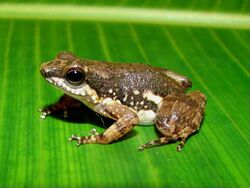Biology:Colostethus inguinalis
| Colostethus inguinalis | |
|---|---|

| |
| Scientific classification | |
| Domain: | Eukaryota |
| Kingdom: | Animalia |
| Phylum: | Chordata |
| Class: | Amphibia |
| Order: | Anura |
| Family: | Dendrobatidae |
| Genus: | Colostethus |
| Species: | C. inguinalis
|
| Binomial name | |
| Colostethus inguinalis (Cope, 1868)
| |
| Synonyms[2] | |
|
Prostherapis inguinalis Cope, 1868 | |
Colostethus inguinalis is a species of frog in the family Dendrobatidae. It is endemic to northwestern and northcentral Colombia.[1][2][3] Its vernacular name is common rocket frog,[2] although this name can also refer to Colostethus panamansis that until 2004 was considered a junior synonym of Colostethus inguinalis.[4] Much of the older literature on Colostethus inguinalis is actually about Colostethus panamansis.[5]
Description
Adult males measure 22–27 mm (0.87–1.06 in) and adult females 23–30 mm (0.91–1.18 in) in snout–vent length. The tympanum is well-defined and pale anteriorly. An oblique lateral pale line extends halfway from groin to the eye- Adult males with solid black throat, with the black pigmentation usually extending onto the chest and the anterior belly; adult females have white (unpigmented) or faintly pigmented gray or brown chest. The toes are moderately webbed. Adult males have swollen third finger.[5]
Habitat and conservation
Colostethus inguinalis is a diurnal species of humid lowland forests at elevations of 0–400 m (0–1,312 ft)[1] or 300–800 m (980–2,620 ft) above sea level,[3] depending on the source. It often occurs along rocky sections of forest streams. The eggs are laid in leaf litter; the adults carry the tadpoles to streams.[1]
It is an abundant species, but deforestation for agricultural development, logging, human settlement, illegal crops, and pollution resulting from the spraying of illegal crops is a major threat; it is suspected that the overall population is declining. This species can be found in a number of protected areas.[1]
References
- ↑ 1.0 1.1 1.2 1.3 1.4 IUCN SSC Amphibian Specialist Group (2018). "Colostethus inguinalis". IUCN Red List of Threatened Species 2018: e.T55096A85892710. doi:10.2305/IUCN.UK.2018-2.RLTS.T55096A85892710.en. https://www.iucnredlist.org/species/55096/85892710. Retrieved 17 November 2021.
- ↑ 2.0 2.1 2.2 Frost, Darrel R. (2019). "Colostethus inguinalis (Cope, 1868)". Amphibian Species of the World: an Online Reference. Version 6.0. American Museum of Natural History. http://research.amnh.org/vz/herpetology/amphibia/Amphibia/Anura/Dendrobatoidea/Dendrobatidae/Colostethinae/Colostethus/Colostethus-inguinalis. Retrieved 7 July 2019.
- ↑ 3.0 3.1 Acosta Galvis, A. R. (2019). "Colostethus inguinalis (Cope, 1868)". Lista de los Anfibios de Colombia: Referencia en linea V.09.2019. https://www.batrachia.com/orden-anura/dendrobatidae-93-spp/colostethus-inguinalis/. Retrieved 7 July 2019.
- ↑ Frost, Darrel R. (2019). "Colostethus panamansis (Dunn, 1933)". Amphibian Species of the World: an Online Reference. Version 6.0. American Museum of Natural History. http://research.amnh.org/vz/herpetology/amphibia/Amphibia/Anura/Dendrobatoidea/Dendrobatidae/Colostethinae/Colostethus/Colostethus-panamansis. Retrieved 7 July 2019.
- ↑ 5.0 5.1 Grant, T. (2004). "On the identities of Colostethus inguinalis (Cope, 1868) and C. panamensis (Dunn, 1933), with comments on C. latinasus (Cope, 1863) (Anura: Dendrobatidae)". American Museum Novitates (3444): 1–24. doi:10.1206/0003-0082(2004)444<0001:otioci>2.0.co;2. https://www.biodiversitylibrary.org/item/292384.
Wikidata ☰ Q1343519 entry
 |


